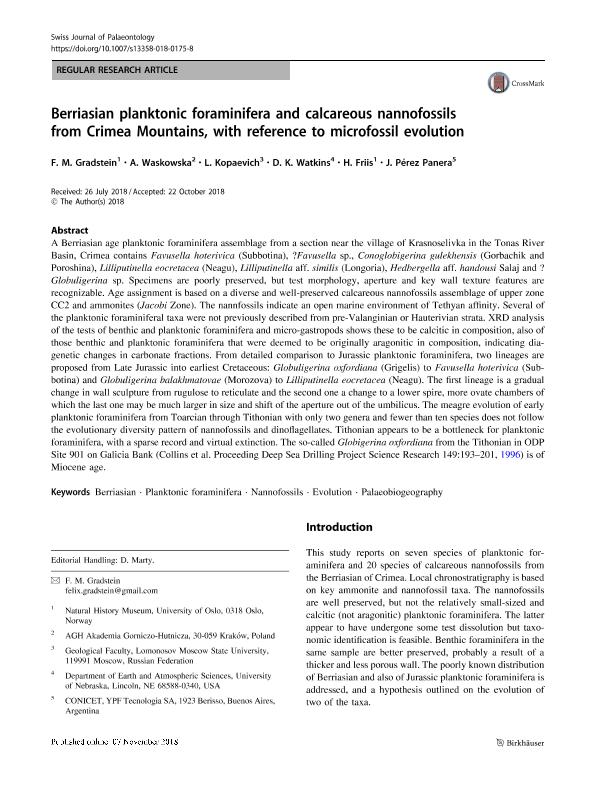Artículo
Berriasian planktonic foraminifera and calcareous nannofossils from Crimea Mountains, with reference to microfossil evolution
Fecha de publicación:
11/2018
Editorial:
Springer
Revista:
Swiss Journal of Palaeontology
ISSN:
1664-2376
e-ISSN:
1664-2384
Idioma:
Inglés
Tipo de recurso:
Artículo publicado
Clasificación temática:
Resumen
A Berriasian age planktonic foraminifera assemblage from a section near the village of Krasnoselivka in the Tonas River Basin, Crimea contains Favusella hoterivica (Subbotina), ?Favusella sp., Conoglobigerina gulekhensis (Gorbachik and Poroshina), Lilliputinella eocretacea (Neagu), Lilliputinella aff. similis (Longoria), Hedbergella aff. handousi Salaj and ? Globuligerina sp. Specimens are poorly preserved, but test morphology, aperture and key wall texture features are recognizable. Age assignment is based on a diverse and well-preserved calcareous nannofossils assemblage of upper zone CC2 and ammonites (Jacobi Zone). The nannfossils indicate an open marine environment of Tethyan affinity. Several of the planktonic foraminiferal taxa were not previously described from pre-Valanginian or Hauterivian strata. XRD analysis of the tests of benthic and planktonic foraminifera and micro-gastropods shows these to be calcitic in composition, also of those benthic and planktonic foraminifera that were deemed to be originally aragonitic in composition, indicating diagenetic changes in carbonate fractions. From detailed comparison to Jurassic planktonic foraminifera, two lineages are proposed from Late Jurassic into earliest Cretaceous: Globuligerina oxfordiana (Grigelis) to Favusella hoterivica (Subbotina) and Globuligerina balakhmatovae (Morozova) to Lilliputinella eocretacea (Neagu). The first lineage is a gradual change in wall sculpture from rugulose to reticulate and the second one a change to a lower spire, more ovate chambers of which the last one may be much larger in size and shift of the aperture out of the umbilicus. The meagre evolution of early planktonic foraminifera from Toarcian through Tithonian with only two genera and fewer than ten species does not follow the evolutionary diversity pattern of nannofossils and dinoflagellates. Tithonian appears to be a bottleneck for planktonic foraminifera, with a sparse record and virtual extinction. The so-called Globigerina oxfordiana from the Tithonian in ODP Site 901 on Galicia Bank (Collins et al. Proceeding Deep Sea Drilling Project Science Research 149:193–201, 1996) is of Miocene age.
Palabras clave:
BERRIASIAN
,
EVOLUTION
,
NANNOFOSSILS
,
PALAEOBIOGEOGRAPHY
,
PLANKTONIC FORAMINIFERA
Archivos asociados
Licencia
Identificadores
Colecciones
Articulos(SEDE CENTRAL)
Articulos de SEDE CENTRAL
Articulos de SEDE CENTRAL
Citación
Gradstein, F. M.; Waskowska, A.; Kopaevich, L.; Watkins, D. K.; Friis, H.; et al.; Berriasian planktonic foraminifera and calcareous nannofossils from Crimea Mountains, with reference to microfossil evolution; Springer; Swiss Journal of Palaeontology; 138; 2; 11-2018; 213-236
Compartir
Altmétricas




